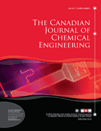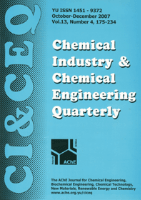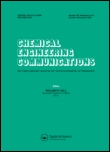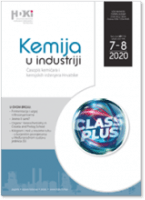
CANADIAN JOURNAL OF CHEMICAL ENGINEERING
Scope & Guideline
Pioneering Research for a Sustainable Future
Introduction
Aims and Scopes
- Chemical Process Design and Optimization:
The journal emphasizes research related to the design, optimization, and simulation of chemical processes, highlighting methodologies like computational fluid dynamics (CFD), model predictive control, and optimization algorithms. - Material Science and Engineering:
Research on advanced materials, including nanomaterials, composites, and catalytic materials, is a core area, focusing on their synthesis, characterization, and application in various chemical processes. - Sustainability and Environmental Engineering:
The journal encourages studies that explore sustainable practices in chemical engineering, including waste minimization, renewable energy integration, and green chemistry applications. - Biochemical and Bioprocess Engineering:
Research in the realm of biochemical processes, including fermentation and bioconversion technologies, is a significant focus, aiming to improve efficiency and effectiveness in producing biofuels and biochemicals. - Separation Processes:
The journal covers advancements in separation technologies, including adsorption, membrane processes, and extraction methods, addressing challenges in industrial applications. - Process Safety and Risk Management:
A commitment to process safety is evident, with articles focusing on risk assessment, hazard analysis, and safety management systems within the chemical engineering domain.
Trending and Emerging
- Artificial Intelligence and Machine Learning Applications:
There is a notable increase in research utilizing AI and machine learning for process optimization, fault detection, and predictive maintenance, showcasing the industry's shift towards data-driven approaches. - Sustainable and Green Chemistry Practices:
Research focusing on sustainable processes, including the use of renewable resources and waste valorization, is increasingly prominent, indicating a strong trend towards environmentally friendly engineering solutions. - Advanced Characterization Techniques:
Emerging trends include the use of advanced characterization methods for materials and processes, such as in-situ monitoring and high-throughput techniques, enhancing the understanding of material behavior. - Nanotechnology and Functional Materials:
The application of nanotechnology in chemical engineering, particularly in catalysis and materials science, is gaining momentum, highlighting the innovative approaches being explored in the field. - Process Safety Innovations:
There is an increasing focus on new methodologies and technologies for enhancing process safety and risk management, reflecting the industry's commitment to improving safety standards.
Declining or Waning
- Traditional Chemical Engineering Unit Operations:
Research focused on basic unit operations such as distillation and crystallization seems to be less prevalent, possibly due to the industry's shift towards more integrated and advanced processing techniques. - Conventional Energy Sources:
As the focus on sustainability increases, traditional fossil fuel-related research appears to be waning, with less emphasis on processes related to oil and gas extraction and refining. - Basic Chemical Reaction Kinetics:
Studies centered around fundamental reaction kinetics without considering advanced modeling or computational approaches seem to be declining, as the field moves towards more complex and integrated modeling techniques.
Similar Journals

Chemical Industry & Chemical Engineering Quarterly
Advancing Chemical Engineering Knowledge, One Quarter at a Time.Chemical Industry & Chemical Engineering Quarterly is a distinguished, open-access journal published by ASSOC CHEMICAL ENG that serves as a vital platform for innovative research within the field of chemical engineering. Established in 2000 and actively disseminating knowledge since then, this journal has garnered acknowledgment for its contribution to the field, currently being ranked in the third quartile (Q3) of Chemical Engineering (Miscellaneous) for 2023. With a focus on advancing understanding of chemical processes and facilitating the integration of industry operations with engineering principles, it provides a forum for both theoretical and applied research. The journal is committed to maintaining high standards of academic rigor, supported by its indexed presence in Scopus, where it ranks #173 out of 273 in the general chemical engineering category. As an open-access journal, it promotes the rapid dissemination of research findings, enhancing accessibility for scholars, professionals, and students worldwide. Based in Serbia, the journal is an essential resource for those seeking to stay at the forefront of chemical engineering advancements.

CHEMICAL ENGINEERING COMMUNICATIONS
Advancing the Frontiers of Chemical Science.Chemical Engineering Communications, published by Taylor & Francis Inc, is a distinguished journal within the realms of Chemical Engineering and Chemistry. With an ISSN of 0098-6445, this journal plays a pivotal role in disseminating innovative research, critical reviews, and insightful discussions that encompass a broad spectrum of topics in these fields. The journal boasts a commendable Q2 ranking in the 2023 category of chemical engineering and general chemistry, reflecting its significant contribution to the scientific community. Operating under a rigorous peer-review process, the journal attracts high-quality submissions from global researchers. Although currently not an Open Access journal, it provides extensive archive access for users interested in exploring past advancements from its inception in 1973 through to 2024. With a commitment to advancing knowledge and fostering collaboration among academia and industry, Chemical Engineering Communications remains an essential resource for professionals and students aiming to stay abreast of the latest developments in chemical sciences.

China Petroleum Processing & Petrochemical Technology
Fueling the future of energy engineering and chemical technology.China Petroleum Processing & Petrochemical Technology is a critical journal published by the China Petroleum Processing & Petrochemical Technology Press, focusing on the pivotal advancements within the field of petroleum processing and petrochemical technology. With ISSN 1008-6234, the journal has been a significant resource since its inception in 1999 and aims to disseminate original research articles, reviews, and case studies that contribute to knowledge and innovation in energy engineering, fuel technology, and chemical engineering. Despite its current Q4 status in various quartile rankings, it provides essential insights and research that are invaluable for researchers, professionals, and students interested in these expanding areas. The journal is located in Beijing, China, and continues to strive for excellence in academia, encouraging contributions that address pressing challenges in the petroleum and petrochemical industries while fostering a deeper understanding of process chemistry and technology.

Journal of Industrial and Engineering Chemistry
Fostering Innovations for a Sustainable TomorrowThe Journal of Industrial and Engineering Chemistry, published by Elsevier Science Inc, stands as a premier platform since its inception in 1996, dedicated to the dissemination of innovative research in the field of Chemical Engineering. Located in South Korea, this influential journal has established itself with an impressive impact factor and is categorized in the Q1 quartile for chemical engineering (miscellaneous), ranking in the top 12% of its category according to Scopus. With a focus on cutting-edge industrial applications, the journal covers a diverse range of topics including chemical processes, engineering innovations, and sustainable practices, appealing to a broad spectrum of researchers, professionals, and students. Although currently not open access, the journal offers a wealth of resources for advancing knowledge and driving forward the chemical engineering discipline. The converged years from 1996 to 2024 reflect its ongoing commitment to excellence and timeliness in publishing high-quality research.

Results in Engineering
Pioneering Solutions for Tomorrow's Engineering ChallengesResults in Engineering is an esteemed open-access journal published by Elsevier, dedicated to advancing the field of engineering through high-quality, innovative research. Since its inception in 2019, this journal has rapidly established itself within the academic community, evidenced by its prestigious Q1 ranking in the Engineering (miscellaneous) category for 2023 and a remarkable ranking of #54 out of 307 in General Engineering according to the Scopus database, placing it in the 82nd percentile of its category. Located in the Netherlands, Results in Engineering provides a global platform for researchers, professionals, and students to disseminate their findings and foster collaboration across diverse engineering disciplines. The journal's commitment to open access ensures that valuable research is accessible to a wider audience, fostering innovation and knowledge sharing. With a progressive approach to publication, Results in Engineering seeks to enhance the engineering landscape by publishing cutting-edge studies that address contemporary challenges and solutions in the field.

ChemEngineering
Innovative Solutions for Today's Chemical Engineering ChallengesChemEngineering is a prominent open-access journal published by MDPI that has been dedicated to the dissemination of high-quality research in the field of chemical engineering since its inception in 2017. Operating out of Switzerland, this journal addresses a diverse range of topics, including energy production, process optimization, and innovations in materials science, thereby attracting contributions from researchers and professionals worldwide. With an impressive Q2 ranking in Chemical Engineering and Engineering, as well as a Q3 ranking in Energy for 2023, ChemEngineering is positioned as a crucial platform for advancing knowledge in its fields. The journal's commitment to open access ensures that its content is readily available to a broad audience, promoting the free exchange of ideas and fostering collaborations. Researchers, professionals, and students alike benefit from the journal's focus on cutting-edge research, making it an essential resource for anyone interested in the ever-evolving landscape of chemical engineering.

KAGAKU KOGAKU RONBUNSHU
Fostering Academic Dialogue in Chemical InnovationKAGAKU KOGAKU RONBUNSHU is a distinguished journal published by the SOC CHEMICAL ENG JAPAN, focusing on the interdisciplinary realms of chemical engineering and chemistry since its inception in 1975. With a commitment to advancing knowledge in these fields, the journal has established itself as a critical forum for researchers, professionals, and students alike, contributing to the understanding and application of chemical processes and materials sciences. Although it operates under a traditional publication model, the journal garners attention within the academic community, reflected in its Q3 rankings in both Chemical Engineering and Chemistry categories as of 2023. With the journal's ISSN 0386-216X and a comprehensive coverage spanning nearly five decades, it remains an essential resource for contemporary chemical research and developments, addressing ongoing challenges and innovative solutions in various applications. The journal invites submissions that reflect the latest advancements and insights in these fields, striving to foster a vibrant academic dialogue and support future innovations.

JOURNAL OF CHEMICAL ENGINEERING OF JAPAN
Catalyzing Knowledge in Chemical ProcessesJOURNAL OF CHEMICAL ENGINEERING OF JAPAN is a distinguished academic publication in the field of chemical engineering and chemistry, published by Taylor & Francis Ltd. With its ISSN 0021-9592 and E-ISSN 1881-1299, this journal has been a vital resource for researchers and practitioners since its inception in 1968 and continues to provide essential insights and advancements through 2024. The journal operates under an Open Access model as of 2023, promoting wider dissemination of research findings and encouraging collaboration within the global scientific community. Currently categorized in the Q4 quartile for both Chemical Engineering and Chemistry (miscellaneous) in 2023, it ranks within the lower percentiles of its respective fields, offering a platform for emerging scholars to publish their work and gain visibility. As part of Japan's academic landscape, it addresses numerous aspects of chemical engineering, fostering innovation and technical development that contribute to the industry's growth. Engaging with this journal is paramount for those looking to stay informed on the latest research trends and applications in chemical processes.

Kemija u Industriji-Journal of Chemists and Chemical Engineers
Fostering collaboration in the realm of chemical engineering.Kemija u Industriji - Journal of Chemists and Chemical Engineers is an esteemed open-access journal published by the HRVATSKO DRUSTVO KEMJIJSKIH INZENJERA I TEHNOLOGA, dedicated to advancing the field of chemical engineering and chemistry. Since its establishment, this journal has served as a pivotal platform for the dissemination of innovative research, technical development, and interdisciplinary studies within the chemical industry. With its ISSN 0022-9830 and E-ISSN 1334-9090, the journal has established a significant international presence, despite its historical discontinuation from Scopus coverage. Researchers and professionals seeking to contribute to or stay updated on the latest advancements in chemical processes, materials science, and engineering practices will find this journal invaluable. Its commitment to open access since 2004 ensures that knowledge is freely available, enhancing collaboration and learning among students, scientists, and engineers alike. With a legacy that reflects the rich tradition of chemical innovation, Kemija u Industriji continues to be a vital resource, promoting the scientific community's synergy and inspiring future breakthroughs.

PROCESS SAFETY AND ENVIRONMENTAL PROTECTION
Driving excellence in safety management and environmental protection.PROCESS SAFETY AND ENVIRONMENTAL PROTECTION, published by Elsevier, is a premier academic journal dedicated to advancing the fields of chemical engineering, environmental science, and safety management. With an impressive impact factor, this esteemed journal undergoes a meticulous peer-review process and serves as a vital platform for researchers, professionals, and students seeking to disseminate cutting-edge research and innovative practices. Submissions are welcome in a wide scope of topics related to safety, risk, reliability, and environmental engineering, demonstrating its influence as a Q1 journal across multiple categories, including Environmental Chemistry and Safety, Risk, Reliability and Quality. By providing a rigorous analysis of current challenges and solutions in the domain since its inception in 1990, it continues to foster interdisciplinary collaboration and practical applications in the United Kingdom and beyond. With the journal not currently offering Open Access options, subscribers gain exclusive access to pivotal insights that shape industry standards and drive advancements in sustainable practices.